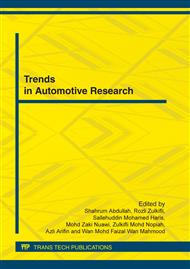p.104
p.109
p.114
p.120
p.125
p.130
p.135
p.140
p.145
Development of 2D Image Capture Method Software for Recognizing Drivers’ Postural Angles
Abstract:
Drivers posture is one of the critical factors that should be investigated closely and thoroughly in the design and development of car drivers seat. A car driver controls the vehicle movements; therefore, his/her safety and comfort is important to avoid any road injury or unfortunate accident. The two main objectives of this study are to develop2D software for capturingimages of drivers postural angles and to collect comfortable drivers postural angles from the participants involved in the study, while they are driving the cars. To achieve this, an experiment was conducted by using this software for collectingcar drivers postural angles. Forty five Malaysian citizens took part in the data collection process. From the study, a 2D image capture method software for capturing driver postural angles were developed. Finally, a range of comfortable postural angles for Malaysian car drivers were proposed based on the participants perception with respect to safety and comfort.
Info:
Periodical:
Pages:
125-129
Citation:
Online since:
April 2012
Authors:
Keywords:
Price:
Сopyright:
© 2012 Trans Tech Publications Ltd. All Rights Reserved
Share:
Citation:


